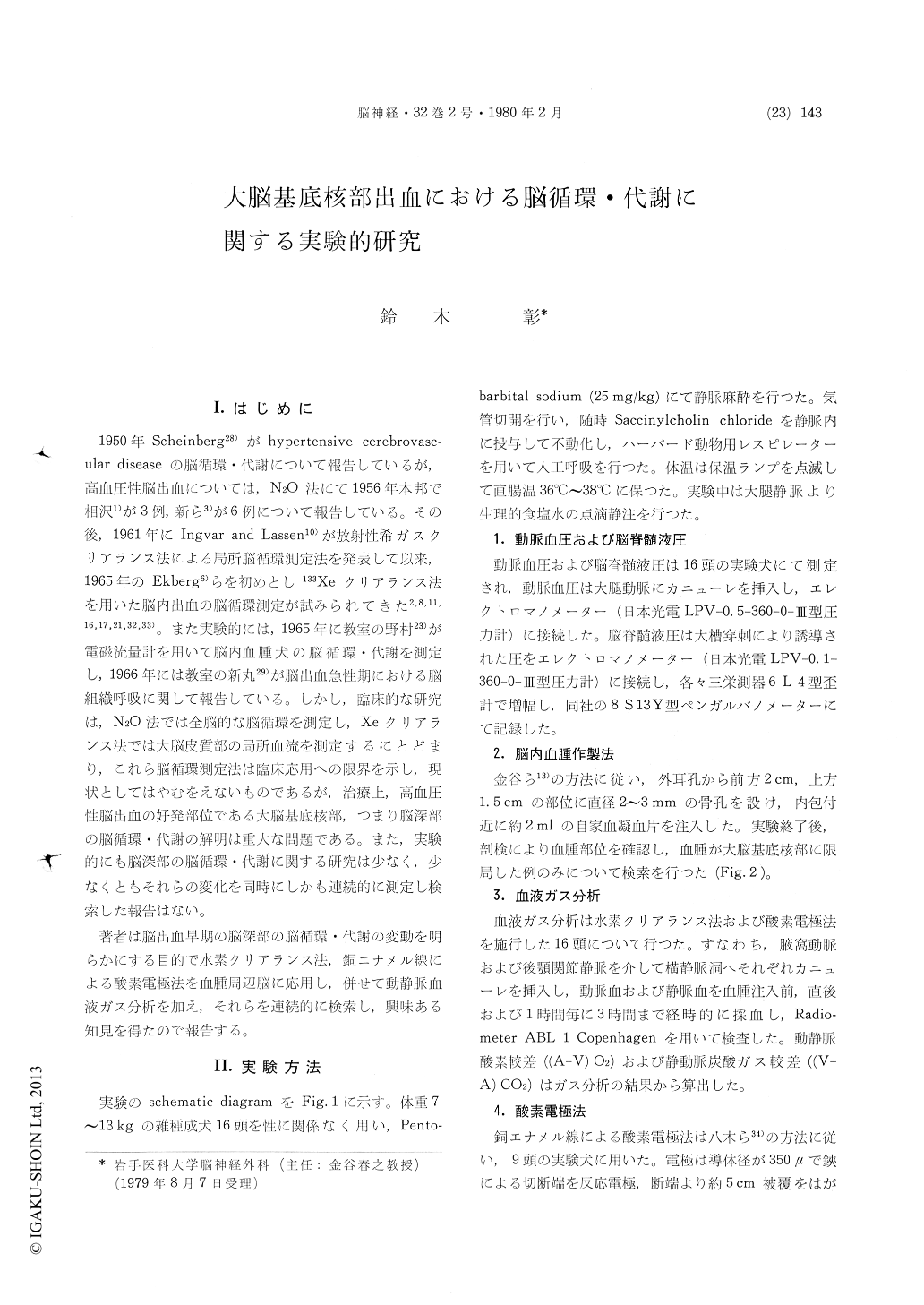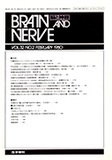Japanese
English
- 有料閲覧
- Abstract 文献概要
- 1ページ目 Look Inside
Ⅰ.はじめに
1950年Scheinberg28)がhypertensive cerebrovasc—ular diseaseの脳循環・代謝について報告しているが,高血圧性脳出血については、N20法にて1956年本邦で相沢1)が3例,新ら3)が6例について報告している。その後,1961年にlngvar and Lassen10)が放射性希ガスクリアランス法による局所脳循環測定法を発表して以来,1965年のEkberg6)らを初めとし133Xeクリアランス法を用いた脳内出血の脳循環測定が試みられてきた2,8,11,16,17,21,32,33)。また実験的には、1965年に教室の野村23)が電磁流量計を用いて脳内血腫犬の脳循環・代謝を測定し,1966年には教室の新丸29)が脳出血急性期における脳組織呼吸に関して報告している。しかし,臨床的な研究は,N20法では全脳的な脳循環を測定し,Xeクリアランス法では大脳皮質部の局所血流を測定するにとどまり,これら脳循環測定法は臨床応用への限界を示し,現状としてはやむをえないものであるが,治療上,高血圧性脳出血の好発部位である大脳基底核部,つまり脳深部の脳循環・代謝の解明は重大な問題である。また,実験的にも脳深部の脳循環・代謝に関する研究は少なく,少なくともそれらの変化を同時にしかも連続的に測定し検索した報告はない。
Intracerebral hematoma was experimentally prod-uced into basal ganglia with autogenous blood in 16 mongrel dogs. Regional cerebral blood flow (rCBF) and regional oxygen tension in cortex, in thalamus and in mesencephalon were measured by hydrogen clearance method and by oxygen 3 hours after injection of hematoma. During each measure-ments, arterial and venous blood were sampled from axillary artery and transverse sinus for gas-ometric analysis. Systemic blood pressure in femo-ral artery and cerebrospinal fluid pressure (CSF-P) in cisterna magna were continously monitored. Oxygen consumption was calculated by multipling rCBF by arterio-venous oxygen content difference.
After injection of hematoma, 1) rCBF in cortex, thalamus and mesencephalon was decreased re-spectively, and no remarkable recovery of the rCBF was found during the experiments. Further, there was no significant difference between the changes of rCBF in each part of the dog brain. 2) A gradual increase of arterio-venous oxygen content difference was found. 3) The calculated oxygen consumption of cortex, thalamus and mesencephalon was remarkablly decreased respectively, and was remained in low level during 3 hours. 4) CSF-P was showed a transient increase in the first 10 minutes, and was increased gradually again after 2 hours. 5) Oxygen tension in carotid artery, detected by oxygen electrode, showed a gradual decrease during the experiments. 6) Oxygen ten-sion in cortex, in thalamus and in mesencephalon was remarkablly decreased, while a gradual recover was found during the experiments. Oftenly, the oxygen tension in cortex and in thalamus showed an overshot response. In contrast, the oxygen tension in mesencephalon showed recovery only.
With these results, 1) It was clear that the intracerebral hematoma decreased not only rCBF but also blood flow of whole brain by reason of increased of (A-V)02 and decreased of oxygen tension in common carotid artery. Furthermore there was no remarkable recovery of cerebral cir-culation during the experiments. 2) By re-increase of CSF-P, brain edema or brain swelling might be existed after injection of hematoma. 3) Increase of the oxygen tension in the dog brain 2 hours after injection of hematoma could be due to de-crease of oxygen consumption in each parts. The calculated oxygen consumption, however, decreased at early time after injection of hematoma. This results might be incorrect, because the oxygen consumption was calculated by multipling rCBF by (A-V)02. Since, the (A-V)02 was changed by whole brain. Therefore, the actual decreased of cerebral oxygen consumption might be started about 2 hours after injection of the intracerebral hematoma.

Copyright © 1980, Igaku-Shoin Ltd. All rights reserved.


